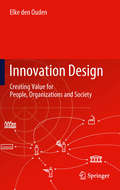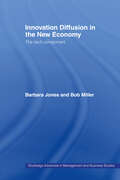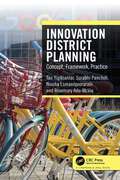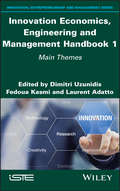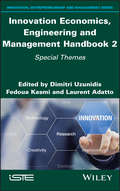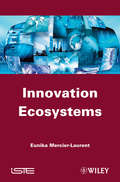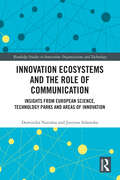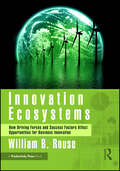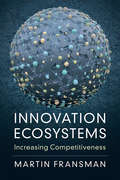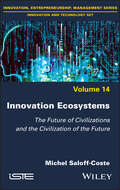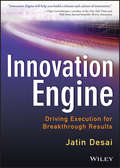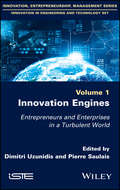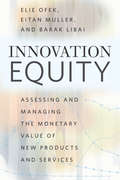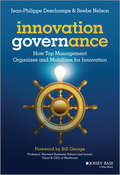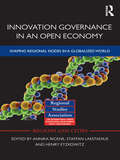- Table View
- List View
Innovation Corrupted: The Rise and Fall of Enron (A)
by Malcolm S. SalterPresents a brief historical overview of Enron's rise, its strategic successes and failures, the evolution of its business model, and the organizational processes relied upon by Enron's management to drive and monitor the business. A rewritten version of an earlier case.
Innovation Design
by Elke Den OudenInnovation Design presents an approach to designing shared value for businesses, non-profit organizations, end-users and society. The societal and economic challenges we are currently facing - such as the aging population, energy scarcity and environmental issues - are not just threats but are also great opportunities for organizations. Innovation Design shows how organizations can contribute to the process of generating value for society by finding true solutions to these challenges. And at the same time it describes how they can capture value for themselves in business ecosystems that care for both people and planet. This book covers: creating meaningful innovations that improve quality of life, engage users and provide value for organizations and other stakeholders, guiding the creation of shared value throughout the innovation process, with a practical and integrative approach towards value that connects ideas from economics, psychology, sociology and ecology, designing new business models and business ecosystems to deliver sustainable benefits for all the involved parties and stakeholders, addressing both tangible and intangible value. Innovation Design gives numerous examples of projects and innovations to illustrate some of the challenges and solutions you may encounter in your journey of designing meaningful innovations and creating shared value. It also offers practical methods and tools that can be applied directly in your own projects. And in a fast-changing world, it provides a context, a framework and the inspiration to create value at every level: for people, for organizations and for the society in which we live.
Innovation Diffusion Models: Theory and Practice
by Mariangela GuidolinInnovation Diffusion Models Understand innovation diffusion models and their role in business success Innovation diffusion models are statistical models that predict the medium- and long-term sales performance of new products on a market. They account for numerous factors that contribute to the life cycle of a new product and are subject to continuous reassessment as markets transform and the business world becomes more complex. In a modern market environment where product life cycles are becoming ever shorter, the latest innovation diffusion models are essential for businesses looking to perfect their decision-making processes. Innovation Diffusion Models: Theory and Practice provides a comprehensive and up-to-date guide to these models and their potential to impact product development. It focuses on the latest product diffusion models, which combine time series analysis with nonlinear regression techniques to create increasingly refined predictions. Its combination of mathematical theory and business practice makes it an indispensable tool across many sectors of industry and commerce. Innovation Diffusion Models readers will also find: Real-world examples demonstrating the kinds of data sets generated by new product growth models and their potential applications Discussion of the factors underlying the decision to select a given growth model for a particular product Clear, detailed explanation of each model’s explanatory ability Innovation Diffusion Models is an essential volume for practitioners in any field of industry or commerce, as well as for graduate students and researchers in business and finance.
Innovation Diffusion in the New Economy: The Tacit Component (Routledge Advances In Management And Business Studies)
by Barbara Jones Bob MillerThis book unites discussions of the philosophical and scientific basis of tacit knowledge.The authors give an overview of the theories of tacit knowledge and explain how these relate to a background of philosophical, neurological and pedagogic literature. The importance of tacit knowledge for evolutionary models of innovation is analyzed raising qu
Innovation District Planning: Concept, Framework, Practice
by Tan Yigitcanlar Surabhi Pancholi Niusha Esmaeilpoorarabi Rosemary Adu-McVieThis book aims to fill the knowledge gap on how to plan, develop and manage innovation districts that are competitive in terms of both productivity and quality of living, justifying the massive investment put into place and at the same time doing both in a delicate and harmonious way.There is a need for smart urban land use that is wired with both hard infrastructures (e.g., telecommunication and transport) and soft infrastructures (e.g., diversity and tolerance). The reader learns this knowledge through conceptual expansions for key insights, frameworks for potential and performance assessment and best practices for global innovation districts. The authors begin innovation district planning with the role and effectiveness of planning a branding in the development of innovation districts. The next key topic of place making is recognised as a key strategy for supporting knowledge generation and innovation activities in the contemporary innovation districts. Another important topic is place quality where the reader learns to identify and classify indicators of place quality by studying global innovation districts best practices. The reader also expands their understanding on the classification of innovation districts based on their key characteristics through a methodological approach. The book concludes with district smartness studied through the socio-cultural role played by anchor universities in facilitating place making in innovation districts. Smart campuses, enabled by digital transformation opportunities in higher education, are seen as a miniature replica of smart cities and serve as living labs for smart technology.The book serves as a repository for scholars, researchers, postgraduate and undergraduate students as it communicates the complex innovation district phenomenon in an easy-to-digest form by providing both the big picture view and specifics of each component of that view.
Innovation Driven Institutional Research: Towards Integral Development (Transformation and Innovation)
by Ronnie LessemThis is the third volume in the CARE-ing for Integral Development series. It continues to build on the previous two works, Community Activation and Awakening Integral Consciousness, as well as preceding the fourth and final book, Embodying Integral Development. This book serves as a follow-up to the author's approach to integral research and development, economics and enterprise, contained within the Innovation and Transformation series, and as a focus for how put all of this "CARE-fully" to work. This third volume, in the CAREquartet is perhaps the most crucial one, building on the organizational systems (see Awakening Integral Consciousness) that came before and turning from trans-cultural and transformational to trans-disciplinary, from integral reality and integral rhythm to integral realms, with a view ultimately to transpersonal, integral rounds. The author turns his attention to research and innovation, and then focuses in on enterprise and economics, management and leadership. As such, he introduces his Inter-Institutional Genealogyin place of an "integral", yet still inhibiting, university. In the process this book paves the way for a new kind of institutionalized, innovation driven social research, which, while rooted in a particular place, speaks to the world as a whole. Moreover, such a research-and-innovation institution has a fundamental role to play in the evolution of a specific community, building on what has come CARE-wise before.
Innovation Drivers and Regional Innovation Strategies (Routledge Studies in Innovation, Organizations and Technology)
by Andrés Rodriguez-Pose M. Davide Parrilli Rune Dahl FitjarIn the global economy, regional development and innovation are increasingly an imperative to increase the competitive edge of EU economies. While European regions are different in many ways, the innovation capacity of regions, clusters and firms is what makes them capable of building up new and diversified pathways for sustainable growth. For this reason, Innovation Drivers and Regional Innovation Strategies looks to analyze different knowledge drivers (e.g. entrepreneurial or policy-orientation; scientific and practice-based knowledge modes; institutional innovation support) that influence the innovative and competitive capacity of regions, clusters and firms in Europe. The aim of this volume is to develop an in-depth understanding of these drivers and their implications for the way in which regional and cluster growth may be upgraded. Innovation Drivers and Regional Innovation Strategies examines the construction of new innovation pathways for regions and clusters in different geographical contexts. The main themes are cluster evolution, regional innovation systems and business innovation modes and capabilities. The objectives are centred on exploring the logic and mechanisms that can be activated as a means to promote innovation and competitiveness within regions and, within these, across and within firms. Aimed at researchers and academics in the field, this is a thoughtful and innovative new volume that helps define the academic debate.
Innovation Economics
by Robert D. AtkinsonThis important book delivers a critical wake-up call: a fierce global race for innovation advantage is under way, and while other nations are making support for technology and innovation a central tenet of their economic strategies and policies, America lacks a robust innovation policy. What does this portend? Robert Atkinson and Stephen Ezell, widely respected economic thinkers, report on profound new forces that are shaping the global economy—forces that favor nations with innovation-based economies and innovation policies. Unless the United States enacts public policies to reflect this reality, Americans face the relatively lower standards of living associated with a noncompetitive national economy. The authors explore how a weak innovation economy not only contributed to the Great Recession but is delaying America's recovery from it and how innovation in the United States compares with that in other developed and developing nations. Atkinson and Ezell then lay out a detailed, pragmatic road map for America to regain its global innovation advantage by 2020, as well as maximize the global supply of innovation and promote sustainable globalization.
Innovation Economics, Engineering and Management Handbook 1: Main Themes
by Dimitri Uzunidis Fedoua Kasmi Laurent AdattoInnovation, in economic activity, in managerial concepts and in engineering design, results from creative activities, entrepreneurial strategies and the business climate. Innovation leads to technological, organizational and commercial changes, due to the relationships between enterprises, public institutions and civil society organizations. These innovation networks create new knowledge and contribute to the dissemination of new socio-economic and technological models, through new production and marketing methods. Innovation Economics, Engineering and Management Handbook 1 is the first of the two volumes that comprise this book. The main objectives across both volumes are to study the innovation processes in today's information and knowledge society; to analyze how links between research and business have intensified; and to discuss the methods by which innovation emerges and is managed by firms, not only from a local perspective but also a global one. The studies presented in these two volumes contribute toward an understanding of the systemic nature of innovations and enable reflection on their potential applications, in order to think about the meaning of growth and prosperity.
Innovation Economics, Engineering and Management Handbook 2: Special Themes
by Dimitri Uzunidis Fedoua Kasmi Laurent AdattoInnovation, in economic activity, in managerial concepts and in engineering design, results from creative activities, entrepreneurial strategies and the business climate. Innovation leads to technological, organizational and commercial changes, due to the relationships between enterprises, public institutions and civil society organizations. These innovation networks create new knowledge and contribute to the dissemination of new socio-economic and technological models, through new production and marketing methods. Innovation Economics, Engineering and Management Handbook 2 is the second of the two volumes that comprise this book. The main objectives across both volumes are to study the innovation processes in today's information and knowledge society; to analyze how links between research and business have intensified; and to discuss the methods by which innovation emerges and is managed by firms, not only from a local perspective but also a global one. The studies presented in these two volumes contribute toward an understanding of the systemic nature of innovations and enable reflection on their potential applications, in order to think about the meaning of growth and prosperity
Innovation Ecosystems (Wiley-iste Ser.)
by Eunika Mercier-LaurentWith innovation fast becoming omnipresent and part of strategic matters, there is a growing need to understand how to jumpstart the innovation process. This book introduces the concept of "e-co-innovation," which fosters the successful transition from idea to reality and ultimate value. It provides a global and system overview of the subject and presents various aspects of innovation from different angles and perspectives, leading to an understanding of all ecosystem components, their metamorphoses, cross-influences and possible impacts on the balanced development of people, businesses, regions and countries.
Innovation Ecosystems and the Role of Communication: Insights from European Science, Technology Parks and Areas of Innovation (Routledge Studies in Innovation, Organizations and Technology)
by Dominika Narożna Justyna AdamskaThis book analyses the role of communication in creating the value of innovation ecosystems from the perspective of the international network of technology parks and areas of innovation. It explores the relations and interactions between different stakeholders (administration, universities, business, innovation agencies), highlighting the important role of communication within successful innovation ecosystems.The role of communication is explained using different levels of communication approach. The authors present communication as a complex process, involving all the ecosystem stakeholders who are as well motivated and involved in different roles, norms, business models, environments, organizations, cultures, etc. The book proposes novel and interdisciplinary research (management, social communication and journalism, political science and administration) focused on the potential of communication in order to design the paradigm and indicate practical implications. The authors take into consideration modern IT tools, which provide the ground for redefining the connections between stakeholders, as well as sustainable development and ESG values, which change the perspective and priorities of the ecosystem.Innovation Ecosystems and the Role of Communication is written for scholars and researchers in the fields of innovation studies, management science, and communication studies.
Innovation Ecosystems: How Driving Forces and Success Factors Affect Opportunities for Business Innovation
by William B RouseThis book is about geography, economics, society, and innovation. Why did different regions evolve in different ways? What caused economic priorities and activities to go in one direction or another? The author believes that happenstance played a relatively minor role in this process. There were and are driving forces, as well as success factors.In each ecosystem, ambitious immigrants arrived, displaced native populations, and proceeded to develop and exploit the geography of their ecosystem, which included leveraging water resources for transportation, commerce, irrigation, etc. They often invented the means of development and exploitation, unfortunately including slavery, but also various technical methods, tools, and devices. Inventions that became innovations enabled industries, revenues, profits, and economic growth, initially for the ecosystem and then more broadly.The impacts of geography and economics are profound. Available resources strongly affect the options available for sustainable economic growth. This growth is fueled by technological innovations that are significantly affected by the physical, economic, and social characteristics of the ecosystem of interest.The eight case studies in this book illustrate how patterns of these characteristics impact innovation. They also depict changes over centuries, rather than just decades or years. Today’s crises are often just blips in the ongoing evolution of an innovation ecosystem. There are ups and downs, but the physical, economic, and social characteristics of the ecosystems dominate their evolution. These factors largely determine what potential innovations are pursued, who leads these pursuits, and why they think they can succeed. People and organizations dominate the factors influencing success.
Innovation Ecosystems: Increasing Competitiveness
by Martin FransmanMartin Fransman presents a new approach to understanding how innovation happens, who makes it happen, and the helps and hindrances. Looking at innovation in real-time under uncertainty, he develops the idea of an 'innovation ecosystem', i.e. a system of interrelated players and processes that jointly make innovation happen. Examples include: how companies like Amazon, Google, Facebook, Apple, AT&T, and Huawei interact in the ICT Ecosystem; four innovations that changed the world - the transistor, microprocessor, optical fibre, and the laser; the causes of the telecoms boom and bust of the early 1990s that influenced the Great Recession from 2007; and the usefulness of the idea of innovation ecosystems for Chinese policy makers. By delving into the complex determinants of innovation this book provides a deeper, more rigorous understanding of how it happens. It will appeal to economists, social scientists, business people, policy makers, and anyone interested in innovation and entrepreneurship.
Innovation Ecosystems: The Future of Civilizations and the Civilization of the Future
by Michel Saloff-CosteOur current situation, marked simultaneously by the Anthropocene, global warming, digitization and exponential artificial intelligence, leads us to sudden and total change in global civilization and, de facto, to rebuilding the foundations of the international economy. Innovation Ecosystems explores the risks and opportunities facing the contemporary world by analyzing, comparing and categorizing the world&’s most dynamic innovation ecosystems by region and city. This includes the identification of key characteristics – common or original – and learning from them in terms of culture, management, system and structure, in order to meet current challenges and think about civilizations of the future.
Innovation Engine
by Jatin DesaiHow to implement an innovation engine in any organization Innovation is often sought and is in high demand today. At the same time it is often misunderstood and lacks committed sponsorship. Today, most teams at the top need an innovation capability in a manner that works in tandem with their performance/operations management. Packed with actionable ideas, references, links, and resources, Innovation Engine meets that need. Reveals how to develop strategy, road maps, and processes for innovation execution Provides high level implementation guidance on executing innovation, something companies are struggling with globally Explores how today's companies can create a long-term sustainable corporate culture by also using an innovation engine Explains how to use innovation to keep employees engaged and motivated Written for executives, business leaders, CFOs, and CIOs Showing readers how to create a business case for innovation and a supporting innovation linked to business vision and goals, Innovation Engine clearly reveals how to reduce time-to-market, while expanding the "idea landscape" and building a pipeline of corporate innovators.
Innovation Engines: Entrepreneurs and Enterprises in a Turbulent World
by Dimitri Uzunidis Pierre SaulaisIn an uncertain economy where business risk is significant, the company tends to rely more on its environment than to invest, for example, in all steps of technological creation; This can be explained by the fact that investments in the acquisition (ownership) of production resources are less expensive than those implied in the formation of these resources; which also explains the attractiveness (in an open economy) of regions with abundant scientific and technical resources. To understand and analyze the innovation process in order to better design and launch new goods, services and technologies, one has to consider the creative dimension of the individual, the business and the organization in general. In new approaches to innovation, the entrepreneur and the company are analyzed through their skills, and their function of resource generation; Innovation thus becomes endogenous, gradual or radical, integrated in a complex process with many feedbacks and interactions. The innovative organization (small or large) is presented in this book as a dynamic system composed of specific and diverse skills (including those of the contractor, engineers or managers). By acquiring, combining and mobilizing these skills, the innovative agent (entrepreneur or company) can create technological resources and develop relations with its environment. Hence the importance of management in design, implementation, protection of intellectual property as well as of the development of new goods, services and technology, commercial and organizational models.
Innovation Equity: Assessing and Managing the Monetary Value of New Products and Services
by Elie Ofek Barak Libai Eitan MullerFrom drones to wearable technology to Hyperloop pods that can potentially travel more than seven hundred miles per hour, we're fascinated with new products and technologies that seem to come straight out of science fiction. But, innovations are not only fascinating, they're polarizing, as, all too quickly, skepticism regarding their commercial viability starts to creep in. And while fortunes depend on people's ability to properly assess their prospects for success, no one can really agree on how to do it, especially for truly radical new products and services. In Innovation Equity, Elie Ofek, Eitan Muller, and Barak Libai analyze how a vast array of past innovations performed in the marketplace--from their launch to the moment they became everyday products to the phase where consumers moved on to the "next big thing." They identify key patterns in how consumers adopt innovations and integrate these with marketing scholarship on how companies manage their customer base by attracting new customers, keeping current customers satisfied, and preventing customers from switching to competitors' products and services. In doing so, the authors produce concrete models that powerfully predict how the marketplace will respond to innovations, providing a much more authoritative way to estimate their potential monetary value, as well as a framework for making it possible to achieve that value.
Innovation Finance and Technology Transfer: Funding Proof-of-Concept (Routledge Studies in Innovation, Organizations and Technology)
by Andrea AlunniOffering proof-of-concept (POC) to inventors is often a difficult task for most Technology Transfer Offices (TTOs). Through an in-depth analysis of 15 years of IP portfolio management by Oxford University Innovation (OUI), this book identifies the salient aspects of the technology transfer evolution and the role that technology transfer managers (TTMs) play in closing the gap between academia and business. Innovation Finance and Technology Transfer: Funding Proof of Concept seeks to prove that a well-managed POC Fund can achieve positive financial results and that the chances for an IP portfolio management to be "in the money" increases if the TTO is attached to an entrepreneurial University. This work illustrates how innovation based on Intellectual Property Rights protected and managed by a highly-skilled group of technology transfer managers succeeds in technology transfer. It offers a vademecum to practitioners to follow a step by step best practice procedure embraced by the Oxford TTO to manage the POC investment process. This book is valuable reading for intellectual property scholars, business school students, social sciences researchers, investment professionals and technology transfer practitioners, as well as those working in innovation think tanks and policy circles.
Innovation Fundamentals: Quantitative and Qualitative Techniques (Systems Innovation Book Series)
by Adedeji B. Badiru Gary LamontThe book uses a systems-based approach to show how innovation is pervasive in all facets of endeavors, including business, industrial, government, the military, and even academia. It presents chapters that provide techniques and methodologies for achieving the transfer of science and technology assets for innovation applications. By introducing Innovation, the book and offers different viewpoints, both qualitative and quantitative. It includes the role that systems can play and discusses approaches along technical and process issues. There is a showcase of innovation applications, and coverage on how to manage innovation individually as well as within a team and it also includes how to develop, manage, and sustain innovation in various organizations. Open-ended questions and exercises are included at the end of chapters with no need for a solutions manual. Written for the advance-level textbook market as well as for the professional reader, it targets those within the engineering, business, and management fields.
Innovation Governance
by Beebe Nelson Jean-Philippe DeschampsThe business leader's guide to encouraging continuous innovation in any organizationInnovation governance is a hot topic in the business world. In a fast-paced business environment, the ability of corporate leaders to build purpose, direction, and focus for innovation is more important than ever. In this book, the authors provide a framework for encouraging and focusing innovation by explaining what innovation governance is, the various models for governance and their advantages and disadvantages, how to assess and improve governance practices, and behavioral tactics for maximizing the effectiveness of governance. It offers guidance for everyone from the boardroom through senior management, illustrating effective governance models with real case studies from a range of companies in the United States and Europe.Addresses an important yet underappreciated skill for CEOs, board members, and top managementFeatures real-world examples and case studies from a variety of business from around the worldWritten by an author team with hands-on experience in the subjects of innovation management, organizational learning, innovation leadership, organizational behavior, and individual leadership and teamworkInnovation governance is a sadly neglected topic in many organizations. This book offers vital guidance and real-world experience for building innovation into any business from the top down.
Innovation Governance in an Open Economy: Shaping Regional Nodes in a Globalized World (Regions and Cities)
by Henry Etzkowitz Annika Rickne Staffan LaestadiusIn an increasingly globalised world, paradoxically regional innovation clusters have moved to the forefront of attention as a strategy for economic and social development. Transcending international success cases, like Silicon Valley and Route 128, as sources of lessons, successful high tech clusters in niche areas have had a significant impact on peripheral regions. Are these successful innovation clusters born or made? If they are subject to planning and direction, what is the shape that it takes: top down, bottom up or lateral?
Innovation Intermediaries and (Final) Frontiers of High-tech: Supporting the New Space Sector in Scotland
by Matjaz VidmarThis book synthesizes the critical advances in holistic understanding of innovation intermediation. It aims to enable researchers, policy-makers, analysts and practitioners to understand and exploit the best practice in designing and deploying interventions in support of an emergent high-tech geographically-bound sectoral innovation system. The book presents a systematic review of innovation intermediaries’ literature and mixed-methods empirical evidence across a range of projects, building a new comprehensive model of activities and resources deployed.The book highlights the emerging New Space industry in Scotland as a primary case study, but lessons learned can applied to scholarly analysis, policy and operational design of all innovation intermediaries’ interventions, which makes this book essential reading in management, innovation studies, political studies and sociology of technology.
Innovation Intermediaries: Enabling Open Innovation
by Henry ChesbroughThis chapter discusses the rise of innovation intermediaries, or firms that help companies of many different sizes participate in the emerging secondary markets for innovation and IP and craft more open business models.
Innovation Killers: How Financial Tools Destroy Your Capacity To Do New Things
by Clayton M. ChristensenIn this seminal article, innovation experts Clayton Christensen, Stephen P. Kaufman, and Willy C. Shih explore the key reasons why companies struggle to innovate. The authors uncover common mistakes companies make--from focusing on the wrong customers to choosing the wrong products to develop--that can derail innovation efforts, and offer a better way forward for management teams who want to avoid these obstacles and get innovation right.

